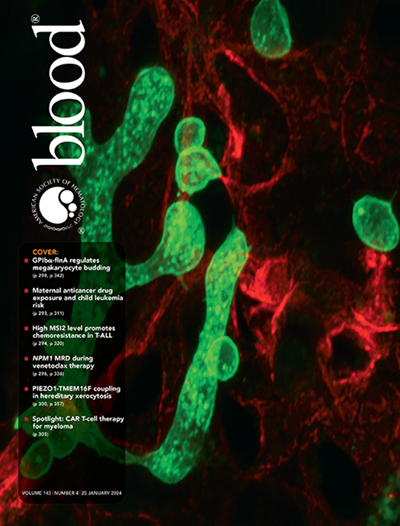The hepcidin-ferroportin axis modulates liver endothelial cell BMP expression to influence iron homeostasis in mice.
IF 21
1区 医学
Q1 HEMATOLOGY
引用次数: 0
Abstract
The liver hormone hepcidin regulates systemic iron homeostasis to provide enough iron for vital processes while limiting toxicity. Hepcidin acts by degrading its receptor ferroportin (encoded by Slc40a1) to decrease iron export to plasma. Iron controls hepcidin production in part by inducing liver endothelial cells (LECs) to produce bone morphogenetic proteins (BMPs), which activate hepcidin transcription in hepatocytes. Here, we used in vitro and in vivo models to investigate whether ferroportin contributes to LEC intracellular iron content to modulate BMP expression and thereby hepcidin. Quantitative proteomics of LECs from mice fed different iron diets demonstrated an inverse relationship between dietary iron and endothelial ferroportin expression. Slc40a1 knockdown primary mouse LECs and endothelial Slc40a1 knockout mice exhibited increased LEC iron and BMP ligand expression. Endothelial Slc40a1 knockout mice also exhibited altered systemic iron homeostasis with decreased serum and total liver iron but preserved erythropoiesis. Although endothelial Slc40a1 knockout mice had similar hepcidin expression as control mice, hepcidin levels were inappropriately high relative to iron levels. Moreover, when iron levels were equalized with iron treatment, hepcidin levels were higher in endothelial Slc40a1 knockout mice than controls. Finally, LEC ferroportin levels were inversely correlated with hepcidin levels in multiple mouse models, and treatment of hepcidin-deficient mice with mini-hepcidin decreased LEC ferroportin expression. Overall, these data show that LEC ferroportin modulates LEC iron and consequently BMP expression to influence hepcidin production. Furthermore, LEC ferroportin expression is regulated by hepcidin, demonstrating bidirectional communication between LECs and hepatocytes to orchestrate systemic iron homeostasis.血钙素-铁蛋白轴调节肝脏内皮细胞BMP的表达,从而影响小鼠体内的铁稳态。
肝脏激素肝磷脂调节全身铁平衡,为生命过程提供足够的铁,同时限制毒性。肝素通过降解其受体铁蛋白(由 Slc40a1 编码)来减少铁向血浆的输出。铁在一定程度上通过诱导肝脏内皮细胞(LECs)产生骨形态发生蛋白(BMPs)来控制肝磷脂酶的产生,而骨形态发生蛋白可激活肝细胞中肝磷脂酶的转录。在这里,我们使用体外和体内模型研究铁蛋白是否有助于LEC细胞内铁含量调节BMP表达,从而调节肝磷脂酶。对喂食不同铁质饮食的小鼠 LECs 进行的定量蛋白质组学研究表明,饮食中的铁与内皮铁蛋白的表达呈反比关系。Slc40a1基因敲除原代小鼠LEC和内皮Slc40a1基因敲除小鼠表现出LEC铁和BMP配体表达增加。内皮 Slc40a1 基因敲除小鼠也表现出全身铁稳态的改变,血清和肝脏总铁减少,但红细胞生成保持不变。虽然内皮细胞 Slc40a1 基因敲除小鼠的血红素表达与对照小鼠相似,但血红素水平相对于铁水平过高。此外,当通过铁处理使铁水平均衡时,内皮 Slc40a1 基因敲除小鼠的血红素水平高于对照组。最后,在多种小鼠模型中,内皮细胞铁蛋白水平与血红素水平成反比,用迷你血红素处理血红素缺陷小鼠会降低内皮细胞铁蛋白的表达。总之,这些数据表明,LEC 铁皮质素可调节 LEC 铁,进而调节 BMP 的表达,从而影响肝素的产生。此外,LEC 铁皮质素的表达受肝磷脂蛋白的调节,这表明 LEC 与肝细胞之间存在双向交流,从而协调全身铁平衡。
本文章由计算机程序翻译,如有差异,请以英文原文为准。
求助全文
约1分钟内获得全文
求助全文
来源期刊

Blood
医学-血液学
CiteScore
23.60
自引率
3.90%
发文量
955
审稿时长
1 months
期刊介绍:
Blood, the official journal of the American Society of Hematology, published online and in print, provides an international forum for the publication of original articles describing basic laboratory, translational, and clinical investigations in hematology. Primary research articles will be published under the following scientific categories: Clinical Trials and Observations; Gene Therapy; Hematopoiesis and Stem Cells; Immunobiology and Immunotherapy scope; Myeloid Neoplasia; Lymphoid Neoplasia; Phagocytes, Granulocytes and Myelopoiesis; Platelets and Thrombopoiesis; Red Cells, Iron and Erythropoiesis; Thrombosis and Hemostasis; Transfusion Medicine; Transplantation; and Vascular Biology. Papers can be listed under more than one category as appropriate.
 求助内容:
求助内容: 应助结果提醒方式:
应助结果提醒方式:


